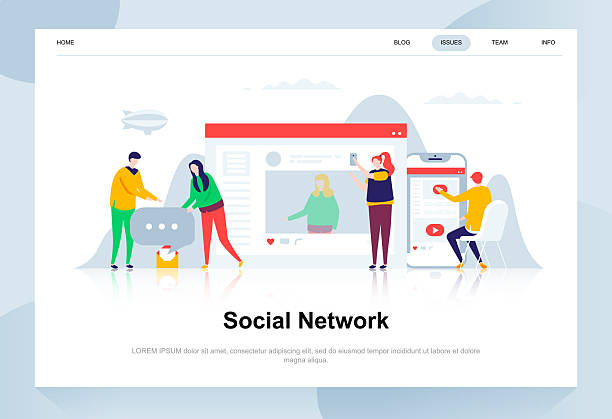Introduction to the Importance of Secure Website Design in the Digital World

In the current era, where the internet has become the lifeblood of businesses and communications, #Web_Security and #Data_Protection are of paramount importance.
A Secure Website Design is no longer an option, but an undeniable necessity.
Websites, as primary gateways for interaction with customers and users, are constantly exposed to various cyber threats.
Disregarding the principles of secure website design can lead to catastrophic consequences: loss of sensitive user data, identity theft, irreparable financial damages, and most importantly, damage to business reputation and trust.
Imagine how a cyber-attack can destroy years of branding efforts in an instant.
This is where discussions related to computer security, and specifically web security, gain double importance.
A proactive approach to security means integrating security considerations from the very initial stages of website design and development.
This approach ensures that the website’s infrastructure and code are robust and impenetrable from the ground up.
The purpose of this educational and explanatory article is to provide a comprehensive view and practical guidance for achieving a truly secure website.
We will strive to assist you in the path of secure website design and sustainability by examining various aspects of web security, from identifying vulnerabilities to implementing best practices.
Is your website truly ready to withstand today’s sophisticated attacks? This is the question we will answer in this article.
Protecting user data and privacy is not only a legal responsibility but also an ethical commitment that every developer and business owner must take seriously.
This is what makes the difference between an ordinary website and a leading website.
Are you falling behind large online stores?
Rasaweb, with professional e-commerce website design, brings your business online and increases your market share!
✅ Increase brand credibility and customer trust
✅ Easy shopping experience leading to more sales
⚡ Act now to receive free website design consultation!
Identifying and Countering the Most Common Web Vulnerabilities

To achieve a secure website design, one must first get to know the enemy.
Numerous #Web_Vulnerabilities exist that hackers exploit to penetrate systems.
Understanding these weaknesses is the first step towards securing your website.
Among the most common and dangerous of these vulnerabilities is SQL Injection.
This attack occurs when an attacker inserts malicious SQL code into input fields (such as search or login forms), tricking the database into stealing or altering sensitive information.
Another case is Cross-Site Scripting (XSS), which allows a hacker to inject malicious client-side code (usually JavaScript) into legitimate web pages.
These codes can steal cookie information, hijack user sessions, and even change the appearance of the page.
In addition, other vulnerabilities such as Broken Authentication, Insecure Direct Object References, and Security Misconfiguration are also among those listed in the OWASP Top 10 and require special attention in the secure website design process.
For example, broken authentication can allow hackers to compromise user accounts or hijack active sessions and exploit unauthorized access.
Insecure direct object references occur when an application exposes a direct reference to an internal object (such as a file or database record) without checking user access, allowing an attacker to gain unauthorized information by altering this reference.
Security misconfiguration can also be the result of insecure defaults, unnecessary enabled services, or manual configuration errors that create entry points for attackers.
This specialized section helps you analytically identify potential weaknesses in your website and prevent malicious attacks by implementing appropriate defensive strategies.
Every step of website development should be done with these vulnerabilities in mind to ensure that each defense layer is properly designed.
Principles of Secure Coding and the Secure Development Lifecycle (SDLC)

One of the most important foundations of secure website design is secure coding.
This approach goes beyond merely fixing bugs after they occur and means embedding security into every stage of #Secure_Web_Development.
Principles such as Input Validation and Output Encoding are of vital importance.
Input validation ensures that user-entered data conforms to application expectations and contains no malicious code.
Output encoding also prevents malicious code from being displayed to the user, especially against XSS attacks.
Furthermore, the Least Privilege Principle means that each user or system component has access only to the minimum resources and permissions necessary to perform its task.
This approach severely limits the scope of damage in the event of a breach.
In addition to secure coding, implementing a Secure Software Development Lifecycle (Secure SDLC) is also essential.
This cycle includes integrating security activities into all stages of the traditional SDLC: from requirements gathering and design, to implementation, testing, deployment, and maintenance.
In the requirements phase, Security Requirements must be clearly defined.
In the design phase, Threat Modeling and risk analysis are performed.
During implementation, the use of secure coding and static code analysis tools (SAST) is recommended.
In the testing phase, security tests such as penetration testing and dynamic code analysis (DAST) are performed.
Even after deployment, there is a need for continuous monitoring and maintenance to identify and address new vulnerabilities.
This specialized and guidance approach ensures that security is an integral part of the development process.
Below is a table of key stages in the Secure Software Development Lifecycle:
| Stage | Key Security Activities | Goal |
|---|---|---|
| Requirements Definition | Defining security requirements, analyzing use cases from a security perspective | Identifying and defining project security objectives |
| Design | Threat modeling, risk analysis, secure architecture selection | Identifying potential threats and designing defense mechanisms |
| Implementation | Secure coding, code review, use of SAST tools | Writing code without vulnerabilities and according to security principles |
| Testing | Penetration testing, vulnerability scanning, dynamic analysis (DAST) | Identifying and fixing vulnerabilities before deployment |
| Deployment | Secure configuration of servers, firewalls, patch management | Ensuring a secure operating environment |
| Maintenance and Monitoring | Security monitoring, incident management, continuous updates | Maintaining system security over time and responding to new threats |
The Importance of SSL/TLS Certificates and Secure Communication Protocols

On the path to secure website design, encrypting information during transmission is of vital importance.
This is where SSL/TLS certificates and the HTTPS protocol come into play.
#SSL_TLS (Secure Sockets Layer/Transport Layer Security) are technologies that provide secure communication between the user’s browser and the website server.
When a website uses HTTPS (the secure version of HTTP), the data exchanged between the user and the server is encrypted.
This means that even if an attacker manages to intercept this data, they will not be able to read or understand it.
This is especially critical for sensitive information such as passwords, banking information, and users’ personal data.
Using HTTPS not only ensures data security but also has other benefits:
- Server Authentication: SSL/TLS certificates assure the user that they are connected to the actual website server, not a fake website created by attackers (phishing).
- Data Integrity: These protocols also ensure that data has not been altered during transmission and is the same information that was sent from the source.
- Better SEO: Search engines like Google prefer HTTPS-enabled websites in their search results rankings over those without it.
This is a positive point for SEO and improves your website’s visibility. - User Trust: The green padlock icon in the browser’s address bar gives users a sense of trust and security and provides a better user experience.
For a secure website, choosing the type of certificate is also important.
DV (Domain Validation) certificates are suitable for blogs and personal sites, while OV (Organization Validation) and EV (Extended Validation) certificates, which have a more rigorous identity verification process, are recommended for businesses and e-commerce websites that process more sensitive information.
This explanatory and specialized section emphasizes the importance of this fundamental layer in web security architecture, as without it, even the strongest security measures will be ineffective.
A secure website design is incomplete without HTTPS.
Are you worried that your company’s old website will drive away new customers? Rasaweb solves this problem with modern and efficient corporate website design.
✅ Increases your brand’s credibility.
✅ Helps attract targeted customers.
⚡ Contact Rasaweb for a free consultation on your corporate website!
User Authentication and Access Management Solutions

One of the sensitive points in any secure website design is how users are authenticated and their access is managed.
#Authentication is the process of verifying a user’s identity, while #Access_Management determines what resources a user can access after authentication.
Proper implementation of these two mechanisms prevents unauthorized access to sensitive website information and functions.
The first and perhaps most important step is to enforce strong password policies.
This includes requiring the use of long, complex passwords (containing uppercase and lowercase letters, numbers, and symbols) and enforcing periodic changes.
Also, passwords should never be stored in plain text in the database; instead, strong hashing functions (such as bcrypt or Argon2) with salt should be used.
Using Multi-Factor Authentication (MFA), such as sending a code to a mobile phone or email, creates an additional powerful security layer.
Even if a user’s password is compromised, the attacker cannot log in without access to the second factor.
For access management, Role-Based Access Control (RBAC) is an effective approach.
In this model, access rights are granted to users based on defined roles (e.g., administrator, editor, regular user), not individually.
This simplifies access management and reduces security errors.
Also, the principle of least privilege applies here: each user or role should only be given the minimum necessary permissions to perform their task.
Proper Session Management is also of high importance.
User sessions should have reasonable expiration times and be properly destroyed after user logout or long periods of inactivity.
Using random and unpredictable Session IDs, and storing them in secure cookies (with HttpOnly and Secure flags), prevents Session Hijacking.
These specialized guidelines are vital for any secure website design, as your system’s entry point, namely authentication and access, must be strongly protected.
Without these measures, even the best security codes will be ineffective.
Data Encryption and User Information Privacy

Within the framework of secure website design, protecting user data, especially sensitive and personal information, is not only an ethical imperative but also a legal requirement in many countries (such as GDPR in Europe).
#Data_Encryption plays a central role in maintaining privacy.
This process transforms data into an unreadable form that can only be recovered with the decryption key.
Encryption should be considered in two main states: Data at Rest and Data in Transit.
Data in Transit Encryption: As mentioned in the SSL/TLS section, the HTTPS protocol encrypts data when it is sent between the user’s browser and the server.
This prevents eavesdropping and data tampering attacks and ensures that sensitive information remains secure throughout the network path.
This is essential for any secure website that exchanges information such as passwords, banking details, or medical information.
Data at Rest Encryption: This refers to encrypting data stored on servers, databases, or storage devices.
Even if an attacker manages to penetrate your server and access database files, if this data is encrypted, it will be useless without the decryption key.
Using strong encryption algorithms such as AES-256 and Secure Key Management are of high importance.
Key storage must be done separately and in highly secure environments.
In addition to encryption, adhering to the principles of #Privacy by Design from the initial design stage is also crucial.
This means integrating privacy considerations into every stage of system design and development.
This includes minimizing data collection, anonymizing or pseudonymizing data where possible, and transparency with users about how their information is used and stored.
This explanatory and specialized section demonstrates how technical measures like encryption, alongside design-oriented approaches, form the main pillars of a secure website design and respect for user privacy.
Security Audits, Penetration Testing, and Continuous Updates

Even with the best secure website design approaches, vulnerabilities can appear over time.
Therefore, regular #Security_Audits and #Penetration_Testing are critical components of any website’s cybersecurity strategy.
Security audits involve a comprehensive review of code, server configurations, and security processes to identify potential weaknesses.
These audits can be performed by internal teams or external security specialists.
Automated vulnerability scanners are useful tools that can quickly identify known vulnerabilities, but they are not a substitute for manual penetration testing.
Penetration Testing (PenTest) is a simulated attack on your system performed by security experts (Pentesters).
The goal of this test is to find weaknesses and ways to penetrate the system before real hackers find them.
Penetration testing can include web application testing, network testing, or social engineering testing.
The results of these tests provide you with a comprehensive report of the vulnerabilities found and recommendations for fixing them.
Penetration testing is an essential investment for any secure website design.
Additionally, Continuous Updates of software, frameworks, and libraries used on your website are crucial.
Attackers constantly look for new vulnerabilities in common software.
The developers of these software also release security patches as soon as vulnerabilities are discovered.
Applying these patches quickly protects your system against known attacks.
Ignoring updates means leaving back doors open for attackers.
This analytical and guidance section reminds you that security is an ongoing process, not a final destination.
The table below introduces some common web security testing tools:
| Tool Name | Type | Main Use |
|---|---|---|
| OWASP ZAP | Vulnerability Scanner (DAST) | Automatic identification of vulnerabilities in running web applications |
| Burp Suite | Penetration Testing Platform | Comprehensive tools for manual and automated web security testing |
| Nessus | Vulnerability Scanner | Identifying vulnerabilities in networks and systems |
| Acunetix | Vulnerability Scanner (DAST/SAST) | Comprehensive platform for scanning websites and web applications |
| SonarQube | Static Code Analysis Tool (SAST) | Analyzing source code quality and security |
Incident Response Planning and Disaster Recovery

Even with the strongest secure website design and adherence to all best practices, the probability of a security incident is never zero.
The important thing is how we prepare for such an event.
Incident Response Planning and Disaster Recovery are two vital components to minimize damages from cyberattacks and ensure business continuity.
The incident response plan should include specific steps: Identification of the attack, Containment to prevent its spread, Eradication of the threat, Recovery of systems and data, and finally, Post-Incident Analysis for learning and improving security processes.
The incident response team must be trained and have the necessary tools for monitoring, digital forensics, and emergency communications.
This informative and guidance section helps you increase your readiness against potential attacks.
Continuous monitoring of system logs and network activities to identify early signs of intrusion (Indicators of Compromise – IoC) is essential.
The sooner you can identify an attack, the higher your chances of containing it and reducing damages.
Also, Disaster Recovery Planning (DRP) is essential to ensure system availability after a major incident (such as hardware failure, natural disasters, or widespread cyberattacks).
This includes regularly backing up data and configurations, storing them in secure and separate locations (off-site), and periodically testing recovery processes.
Having Redundancy systems and Business Continuity Plans also ensures that even if parts of the system fail, critical services will not be interrupted.
This proactive and reactive approach complements a comprehensive secure website design and gives you more peace of mind against threats.
Still don’t have a corporate website and losing online opportunities? With professional corporate website design by Rasaweb,
✅ Double your business credibility
✅ Attract new customers
⚡ Free consultation for your corporate website!
The Role of the Human Factor in Web Security and Necessary Training

In the discussion of secure website design, the focus is often on technical aspects such as coding, firewalls, and encryption, but the role of the human factor should not be underestimated.
Many security incidents occur not due to technical weaknesses, but as a result of #Human_Error or #Social_Engineering attacks.
Hackers know that humans are the weakest link in the security chain and exploit this weakness.
Attacks such as Phishing, Spear Phishing, and Vishing all rely on tricking individuals into revealing sensitive information or performing malicious actions.
This engaging and educational section emphasizes the importance of awareness.
Security Awareness Training is essential for all individuals involved with the website, from developers and system administrators to end-users.
- For Developers: Specialized training in secure coding, understanding common vulnerabilities, and proper use of secure frameworks and libraries.
They should be familiar with OWASP Top 10 principles and use code analysis tools. - For System Administrators: Training on secure server configuration, firewalls, patch management, and log monitoring.
Familiarity with methods for preventing DDoS attacks and managing access. - For End-Users: Training on identifying phishing emails, the importance of using strong and unique passwords, enabling Multi-Factor Authentication, and avoiding clicking suspicious links.
They should know how to protect their personal information online.
Creating a security-oriented culture within the organization, where everyone understands their responsibility for system security, is very important.
This culture should be promoted from top-down (from senior management) and reinforced through continuous training, attack simulations (e.g., internal phishing tests), and transparent communication.
Learning how to react to social engineering attempts can be the difference between a major security incident and a harmless alert.
Ultimately, without human awareness and cooperation, even the strongest technical measures in secure website design may prove ineffective.
Future Trends in Web Security and Preparing for New Challenges

The world of cybersecurity is constantly evolving, with attackers and defenders continuously competing.
To maintain a secure website design in the long run, one must look at #Future_Web_Security_Trends and emerging challenges.
One of the most important trends is the increasing use of #Artificial_Intelligence and Machine Learning (AI/ML) on both sides of the front.
Hackers use AI to automate attacks, identify vulnerabilities, and even create more advanced malware.
On the other hand, security experts also leverage AI/ML to detect unusual patterns, anomalies, and strengthen their defense systems.
This is a continuous battle of wits.
Other trends include increased attacks on the Internet of Things (IoT) and connected devices, which can serve as new entry points for cyberattacks on websites, as well as threats related to Cloud Computing.
With the increasing use of cloud infrastructure, the security of configurations and data in the cloud environment becomes highly important.
Also, Blockchain technology has also created potential for improving security, especially in the areas of decentralized authentication and identity management.
The fundamental question posed in this analytical and thought-provoking content section is, “Is our website ready to face tomorrow’s threats?” The answer lies in a dynamic and adaptable approach to change.
This means continuous investment in research and development, team training, and ongoing updates to security strategies.
Cybersecurity is a journey, not a destination. Websites must be flexible to cope with unknown future challenges.
This includes using scalable security architectures, adopting new security innovations, and also participating in the security community and exchanging information with others to stay informed about the latest threats and defenses.
The sustainability of a secure website design depends on its capacity for adaptation and evolution.
Frequently Asked Questions
| No. | Question | Answer |
|---|---|---|
| 1 | What does secure website design mean? | Secure website design refers to a set of measures and methods used to protect a website against cyberattacks, unauthorized access, data breaches, and other security threats. Its goal is to maintain the confidentiality, integrity, and availability of information. |
| 2 | Why is website security important? | Website security is crucial for maintaining user trust, protecting sensitive information (such as personal and financial data), preventing financial losses, preserving brand reputation, and complying with legal regulations (such as GDPR). A security breach can lead to customer loss and heavy penalties. |
| 3 | What are some of the most common security attacks against websites? | The most common attacks include SQL Injection, XSS (Cross-Site Scripting), CSRF (Cross-Site Request Forgery), Brute Force, DDoS attacks, Broken Authentication, and Missing Function Level Access Control. |
| 4 | What is the role of SSL/TLS certificates in website security? | SSL/TLS certificates (which lead to HTTPS addresses) are used to encrypt data exchanged between the user and the website server. This prevents eavesdropping or tampering with sensitive information such as passwords and credit card details during transmission and verifies the website’s authenticity. |
| 5 | How can SQL Injection attacks be prevented? | To prevent SQL Injection, it is necessary to use Prepared Statements or ORM (Object-Relational Mapping) with validated parameters. Additionally, strict filtering and validation of user inputs and applying the principle of least privilege in the database are essential. |
| 6 | What is HTTP Strict Transport Security (HSTS) and how does it help security? | HSTS is a web security policy that tells browsers to load the website only via an HTTPS connection, even if the user enters the address with HTTP. This prevents Downgrade attacks and cookie theft on public Wi-Fi networks. |
| 7 | What is the importance of regularly updating software and plugins in website security? | Regularly updating the Content Management System (CMS), plugins, themes, and other software components of the site is crucial to fix discovered security vulnerabilities. Developers constantly release security patches, and failing to update can leave the site vulnerable to known attacks. |
| 8 | What actions can be taken to increase the security of the website administration section (admin panel)? | Changing the default admin panel path, using strong passwords and two-factor authentication (2FA), restricting access to specific IPs, using CAPTCHA on login pages, monitoring logs, and continuously updating the CMS are among these measures. |
| 9 | Why is filtering and validating user inputs (Input Validation) important? | Filtering and validating inputs helps prevent the injection of malicious code or unauthorized data through forms, URLs, or other user input sections. This prevents attacks such as XSS and SQL Injection that exploit invalid inputs. |
| 10 | Name some common tools or services for checking and increasing website security. | Tools such as Web Application Firewalls (WAF), vulnerability scanners (e.g., Acunetix, Nessus), Intrusion Detection/Prevention Systems (IDS/IPS), CDN services with security features (e.g., Cloudflare), and periodic Penetration Testing can enhance website security. |
And other services of Rasa Web Advertising Agency in the field of advertising
Smart Customer Journey Map: An innovative service to improve SEO ranking through user experience customization.
Smart Digital Advertising: An innovative service to increase customer acquisition through the use of real data.
Smart SEO: A specialized service for increasing website visits based on intelligent data analysis.
Smart SEO: A fast and efficient solution for online growth focusing on the use of real data.
Smart Advertorial: An effective tool for increasing sales through intelligent data analysis.
And over hundreds of other services in the field of internet advertising, advertising consultation, and organizational solutions
Internet Advertising | Advertising Strategy | Advertorial
Sources
Comprehensive Guide to Website Protection
Methods for Securing User Data
Principles of Secure Website Design
Web Security Standards
? Are you ready for your business to leap forward in the digital world? Rasaweb Afarin Digital Marketing Agency, by providing innovative solutions in user-friendly website design, search engine optimization (SEO), and targeted advertising campaigns, is your strategic partner on the path to reaching the peak. Let’s build your business’s digital future together.
📍 Tehran, Mirdamad Street, next to Bank Markazi, Southern Kazeroun Alley, Ramin Alley, No. 6




